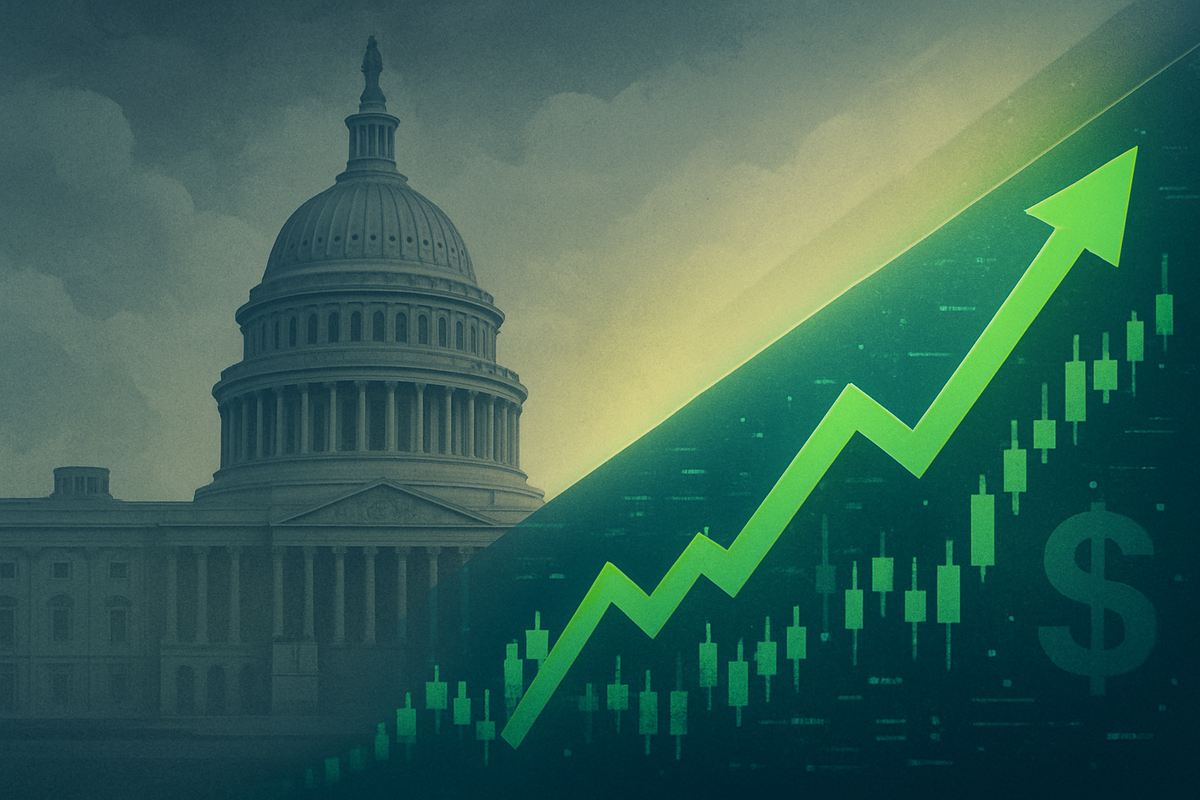Financial News
Longest U.S. Government Shutdown Nears Resolution, Sending Stock Futures Soaring

WASHINGTON D.C. – The United States finds itself in unprecedented territory as the government shutdown, now in its 40th day as of November 9, 2025, marks the longest such impasse in the nation's history. This prolonged stalemate, which began on October 1, 2025, has cast a shadow of uncertainty over the economy and financial markets, leading to furloughs for hundreds of thousands of federal employees and the suspension of numerous critical government functions.
However, a glimmer of hope emerged on Saturday, November 9, 2025, as reports indicated significant progress towards a bipartisan deal in the U.S. Senate to end the shutdown. This news swiftly ignited a wave of optimism across financial markets, with stock futures surging as investors eagerly anticipated an end to the fiscal gridlock that has weighed heavily on sentiment. The market's immediate positive reaction underscores the deep desire for stability and predictability in Washington.
A Historic Impasse: Details, Timeline, and Initial Market Response
The current government shutdown commenced at midnight EDT on October 1, 2025, after Congress failed to pass the necessary appropriations legislation for the 2026 fiscal year. The core of the dispute revolves around contentious issues, including the extension of Affordable Care Act subsidies and proposed budget cuts, reflecting a deeply divided political landscape. This failure to reach a consensus has resulted in the furlough of approximately 900,000 federal employees, while another two million continue to work without pay, facing significant financial strain.
Over the past six weeks, the shutdown has systematically impacted various government agencies and services. While essential functions such as Medicare and Medicaid have largely continued, critical programs administered by entities like the National Institutes of Health, the Centers for Disease Control and Prevention, and the Women, Infants, and Children (WIC) program have faced partial or full suspensions. This disruption has not only affected government operations but has also created a ripple effect, impacting businesses reliant on federal contracts and individuals dependent on government services.
Key players in this prolonged standoff include the Biden Administration, led by President Joe Biden, and the leadership of both the House of Representatives and the Senate. Intense negotiations have been ongoing behind closed doors, often characterized by partisan rhetoric and seemingly insurmountable differences. However, the breakthrough on November 9, 2025, signaling a potential bipartisan deal in the Senate, represents a crucial turning point, suggesting that compromise may finally be within reach.
The initial market reaction to the news of a potential resolution was overwhelmingly positive. U.S. stock futures, which had been exhibiting volatility and cautious sentiment throughout the shutdown, saw a notable surge. This immediate uplift reflects the market's tendency to price in an eventual resolution to political impasses and its inherent desire for certainty. While the broader economic impact of a prolonged shutdown can be significant, the prospect of its conclusion provides a much-needed boost to investor confidence, signaling that the worst of the political uncertainty might soon be over.
Companies on the Cusp: Winners and Losers in the Shutdown's Wake
The U.S. government shutdown has created a distinct landscape of winners and losers across various industries, with the prospect of a resolution now poised to shift dynamics once more. Companies heavily reliant on government contracts, regulatory approvals, or federal funding have borne the brunt of the impasse, while others, less exposed or offering essential services, have shown greater resilience.
Among the hardest hit are defense contractors and aerospace companies, such as Lockheed Martin (NYSE: LMT), Boeing (NYSE: BA), and Raytheon Technologies (NYSE: RTX). These giants depend on continuous government contracts, procurement, and payment cycles, all of which can be delayed or disrupted during a shutdown. While long-term contracts often have built-in protections, the uncertainty surrounding new orders and the processing of existing ones can impact cash flow and project timelines. The resolution of the shutdown would immediately alleviate these pressures, allowing for the resumption of normal business operations and the release of delayed payments.
Conversely, some sectors and companies have historically shown more resilience or even benefited indirectly. Defensive sectors like utilities and certain healthcare providers, whose services are deemed essential regardless of government operations, tend to be less affected. Additionally, companies providing cloud services or cybersecurity solutions to government agencies, even those deemed non-essential, often have contracts structured to continue, or their services become even more critical during periods of heightened uncertainty. For instance, companies like Amazon Web Services (NASDAQ: AMZN) and Microsoft (NASDAQ: MSFT), which provide significant cloud infrastructure to federal agencies, might see a resumption of stalled projects or new initiatives once funding is restored. The lifting of the shutdown could also see a rebound in consumer discretionary spending, benefiting retailers and leisure companies, as furloughed federal workers receive back pay and economic confidence improves.
Wider Significance: Economic Ripple Effects and Historical Context
The ongoing U.S. government shutdown, now the longest in history, transcends immediate political squabbles, embedding itself within broader economic and industry trends. Its protracted nature amplifies concerns about the stability of U.S. governance and its capacity to manage fiscal responsibilities, potentially impacting the nation's standing on the global stage. The inability to pass appropriations legislation signals a deeper partisan divide that could continue to hinder future policy-making, affecting everything from infrastructure spending to technological innovation.
The ripple effects of such an extended shutdown are far-reaching. Beyond the direct impact on federal employees and contractors, the lack of crucial economic data releases – including jobs reports, inflation figures, and GDP estimates – leaves investors, businesses, and even the Federal Reserve flying blind. This data vacuum complicates monetary policy decisions, hinders business planning, and can lead to misallocations of capital. Small businesses reliant on federal loans or permits face significant delays, potentially stifling growth and job creation. Competitors in international markets may also perceive U.S. economic and political instability as an opportunity to gain an advantage, particularly in sectors like technology and manufacturing.
Historically, government shutdowns have typically had a modest, short-term impact on the overall economy and stock market. The S&P 500 has often rebounded quickly after resolutions. However, the unprecedented length of the current shutdown, at 40 days, differentiates it from previous events. While past shutdowns, such as the 35-day closure in 2018-2019, resulted in measurable, albeit temporary, reductions in GDP growth, the current scenario presents a more significant risk of sustained economic damage. Each week of closure is estimated to reduce annualized GDP growth by approximately 0.1 to 0.15 percentage points, suggesting the current shutdown could shave a substantial amount from the fourth quarter's economic output, potentially increasing the risk of a broader economic slowdown if not swiftly resolved.
What Comes Next: Navigating the Path Forward
With optimism swirling around a potential resolution to the longest U.S. government shutdown, attention now shifts to the immediate and long-term implications for the market and economy. In the short term, the most immediate outcome of a deal will be the resumption of federal services, the return of furloughed employees, and the release of delayed economic data. This influx of information will be crucial for investors and policymakers to accurately assess the damage incurred during the shutdown and recalibrate their strategies. Stock futures are likely to maintain their upward trajectory upon official confirmation of a deal, reflecting a collective sigh of relief and a return of investor confidence.
Looking further ahead, the resolution of this shutdown may still leave lingering questions regarding future fiscal stability. The underlying political divisions that led to this impasse are unlikely to disappear, suggesting that similar budgetary showdowns could recur. This necessitates potential strategic pivots for businesses, particularly those with significant government exposure, to build greater resilience against future disruptions. This could involve diversifying client bases, building larger cash reserves, or developing contingency plans for delayed payments and regulatory approvals.
Market opportunities may emerge in sectors that were disproportionately impacted by the shutdown, as a surge in pent-up demand or delayed projects comes online. Conversely, challenges remain, including the potential for a slower-than-expected economic recovery if the shutdown's effects are more deeply embedded than anticipated. Investors will be closely watching for signs of consumer spending rebound, the pace of federal project resumptions, and any lasting impact on business investment. Potential scenarios range from a swift, V-shaped recovery in affected sectors to a more gradual, U-shaped rebound, depending on the severity of the economic scarring from the prolonged closure.
Comprehensive Wrap-up: Assessing the Market Moving Forward
The U.S. government's 40-day shutdown, a historic and disruptive event, appears to be nearing its conclusion, bringing with it a wave of relief and renewed optimism in financial markets. The key takeaway from this prolonged impasse is the profound impact of political stability on economic sentiment. While markets have historically shown resilience to shorter shutdowns, the sheer duration of this one underscored the risks of sustained uncertainty, affecting everything from federal services to critical economic data releases. The surge in stock futures on news of a potential deal on November 9, 2025, vividly illustrates the market's strong preference for resolution and predictability.
Moving forward, the market will assess the full extent of the shutdown's economic damage. While the immediate boost from a resolution is expected, investors will scrutinize forthcoming economic reports – once they resume – to understand the true cost in terms of lost GDP, delayed business activity, and consumer confidence. The resilience of public companies (NYSE: SPX) (NASDAQ: COMP) (NYSE: DJIA) will be tested as they navigate the backlog of government operations and adjust to potentially altered regulatory environments.
In the coming months, investors should closely monitor several key indicators: the pace of federal agencies returning to full operation, the swiftness with which delayed payments and contracts are processed, and any revisions to economic forecasts. Furthermore, attention will turn to the broader political climate, watching for signs that the underlying causes of this shutdown have been addressed, or if similar fiscal cliffs loom on the horizon. The lasting impact of this shutdown will depend not just on its end, but on the lessons learned by policymakers and the subsequent actions taken to prevent a recurrence of such a debilitating event.
This content is intended for informational purposes only and is not financial advice
More News
View More




Recent Quotes
View More
Quotes delayed at least 20 minutes.
By accessing this page, you agree to the Privacy Policy and Terms Of Service.



